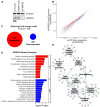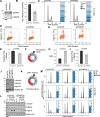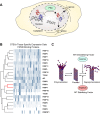The prolyl isomerase FKBP25 regulates microtubule polymerization impacting cell cycle progression and genomic stability
- PMID: 29361176
- PMCID: PMC5861405
- DOI: 10.1093/nar/gky008
The prolyl isomerase FKBP25 regulates microtubule polymerization impacting cell cycle progression and genomic stability
Abstract
FK506 binding proteins (FKBPs) catalyze the interconversion of cis-trans proline conformers in proteins. Importantly, FK506 drugs have anti-cancer and neuroprotective properties, but the effectors and mechanisms underpinning these properties are not well understood because the cellular function(s) of most FKBP proteins are unclear. FKBP25 is a nuclear prolyl isomerase that interacts directly with nucleic acids and is associated with several DNA/RNA binding proteins. Here, we show the catalytic FKBP domain binds microtubules (MTs) directly to promote their polymerization and stabilize the MT network. Furthermore, FKBP25 associates with the mitotic spindle and regulates entry into mitosis. This interaction is important for mitotic spindle dynamics, as we observe increased chromosome instability in FKBP25 knockdown cells. Finally, we provide evidence that FKBP25 association with chromatin is cell-cycle regulated by Protein Kinase C phosphorylation. This disrupts FKBP25-DNA contacts during mitosis while maintaining its interaction with the spindle apparatus. Collectively, these data support a model where FKBP25 association with chromatin and MTs is carefully choreographed to ensure faithful genome duplication. Additionally, they highlight that FKBP25 is a MT-associated FK506 receptor and potential therapeutic target in MT-associated diseases.
Figures









Similar articles
-
The prolyl isomerase, FKBP25, interacts with RNA-engaged nucleolin and the pre-60S ribosomal subunit.RNA. 2014 Jul;20(7):1014-22. doi: 10.1261/rna.042648.113. Epub 2014 May 19. RNA. 2014. PMID: 24840943 Free PMC article.
-
The 25-kDa FK506-binding protein is localized in the nucleus and associates with casein kinase II and nucleolin.Proc Natl Acad Sci U S A. 1993 Aug 15;90(16):7769-73. doi: 10.1073/pnas.90.16.7769. Proc Natl Acad Sci U S A. 1993. PMID: 7689229 Free PMC article.
-
FKBP25 participates in DNA double-strand break repair.Biochem Cell Biol. 2020 Feb;98(1):42-49. doi: 10.1139/bcb-2018-0328. Epub 2019 Jan 8. Biochem Cell Biol. 2020. PMID: 30620620 Free PMC article.
-
Resolving the functions of peptidylprolyl isomerases: insights from the mutagenesis of the nuclear FKBP25 enzyme.Biochem Soc Trans. 2013 Jun;41(3):761-8. doi: 10.1042/BST20130013. Biochem Soc Trans. 2013. PMID: 23697935 Review.
-
Prolyl cis-trans isomerization as a molecular timer.Nat Chem Biol. 2007 Oct;3(10):619-29. doi: 10.1038/nchembio.2007.35. Nat Chem Biol. 2007. PMID: 17876319 Review.
Cited by
-
FKBP52 in Neuronal Signaling and Neurodegenerative Diseases: A Microtubule Story.Int J Mol Sci. 2022 Feb 3;23(3):1738. doi: 10.3390/ijms23031738. Int J Mol Sci. 2022. PMID: 35163662 Free PMC article. Review.
-
Dual enhancement in the radiosensitivity of prostate cancer through nanoparticles and chemotherapeutics.Cancer Nanotechnol. 2023;14(1):75. doi: 10.1186/s12645-023-00228-0. Epub 2023 Sep 29. Cancer Nanotechnol. 2023. PMID: 37781236 Free PMC article.
-
FKBP3 aggravates the malignant phenotype of diffuse large B-cell lymphoma by PARK7-mediated activation of Wnt/β-catenin signalling.J Cell Mol Med. 2024 Jan;28(1):e18041. doi: 10.1111/jcmm.18041. Epub 2023 Nov 21. J Cell Mol Med. 2024. PMID: 37987202 Free PMC article.
-
The quantification and regulation of microtubule dynamics in the mitotic spindle.Curr Opin Cell Biol. 2019 Oct;60:36-43. doi: 10.1016/j.ceb.2019.03.017. Epub 2019 May 17. Curr Opin Cell Biol. 2019. PMID: 31108428 Free PMC article. Review.
-
The eEF1 family of mammalian translation elongation factors.BBA Adv. 2022 Nov 30;3:100067. doi: 10.1016/j.bbadva.2022.100067. eCollection 2023. BBA Adv. 2022. PMID: 37082266 Free PMC article.
References
-
- Weiss M.S., Jabs A., Hilgenfeld R.. Peptide bonds revisited. Nat. Struct. Mol. Biol. 1998; 5:676–676. - PubMed
-
- Stewart D.E., Sarkar A., Wampler J.E.. Occurrence and role of cis peptide bonds in protein structures. J. Mol. Biol. 1990; 214:253–260. - PubMed
-
- Chelu M.G., Danila C.I., Gilman C.P., Hamilton S.L.. Regulation of ryanodine receptors by FK506 binding proteins. Trends Cardiovasc. Med. 2004; 14:227–234. - PubMed
Publication types
MeSH terms
Substances
LinkOut - more resources
Full Text Sources
Other Literature Sources
Molecular Biology Databases

